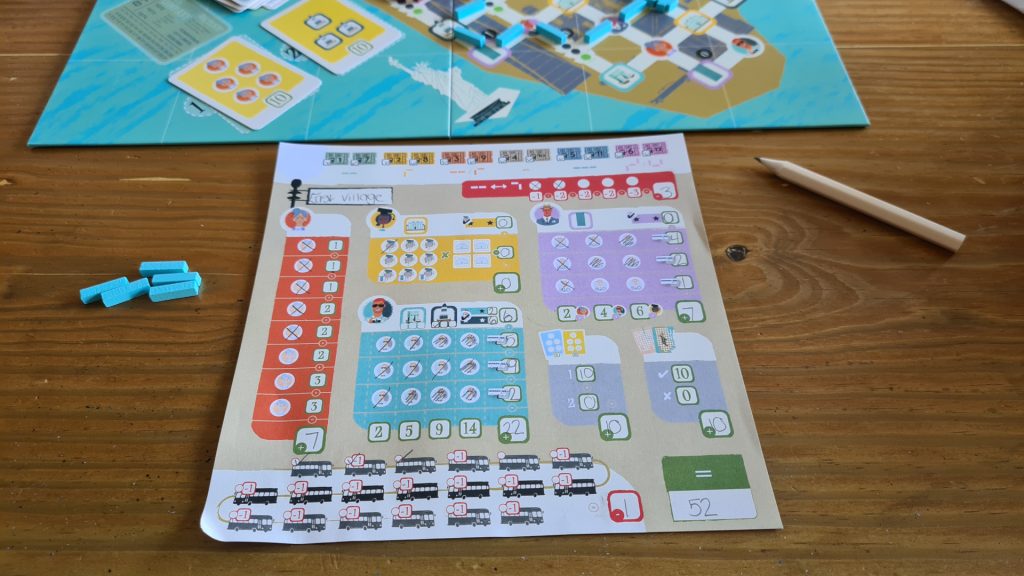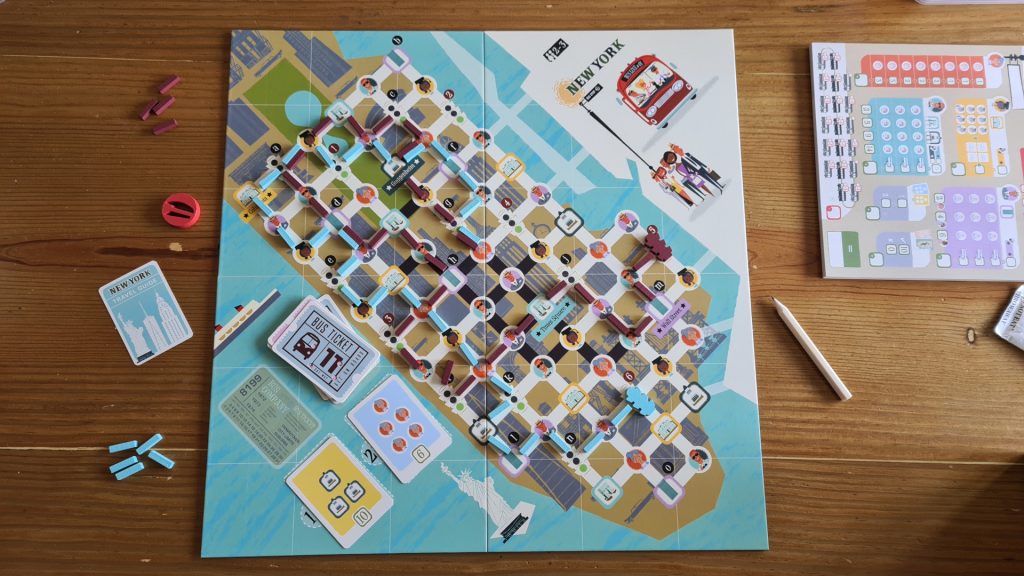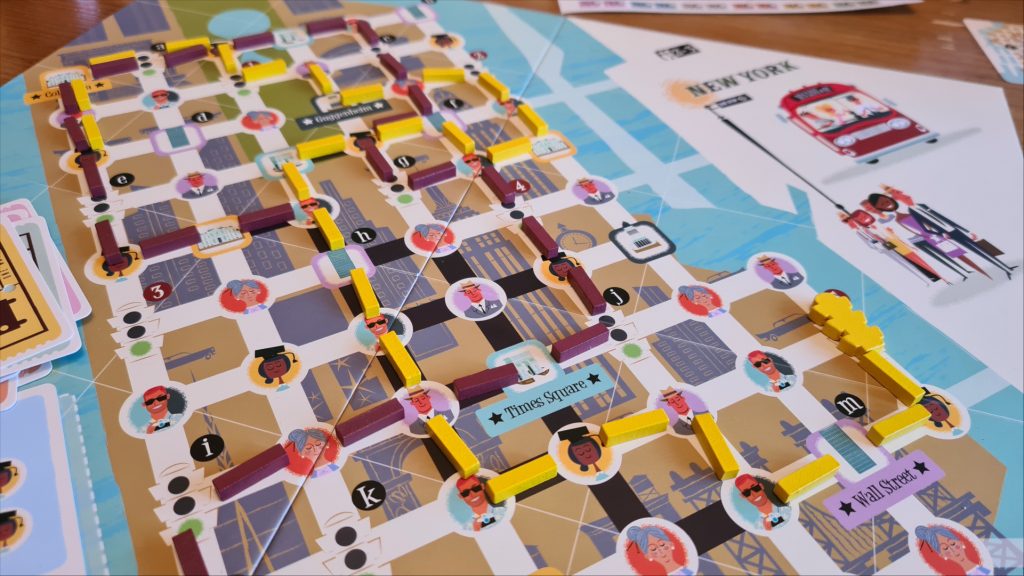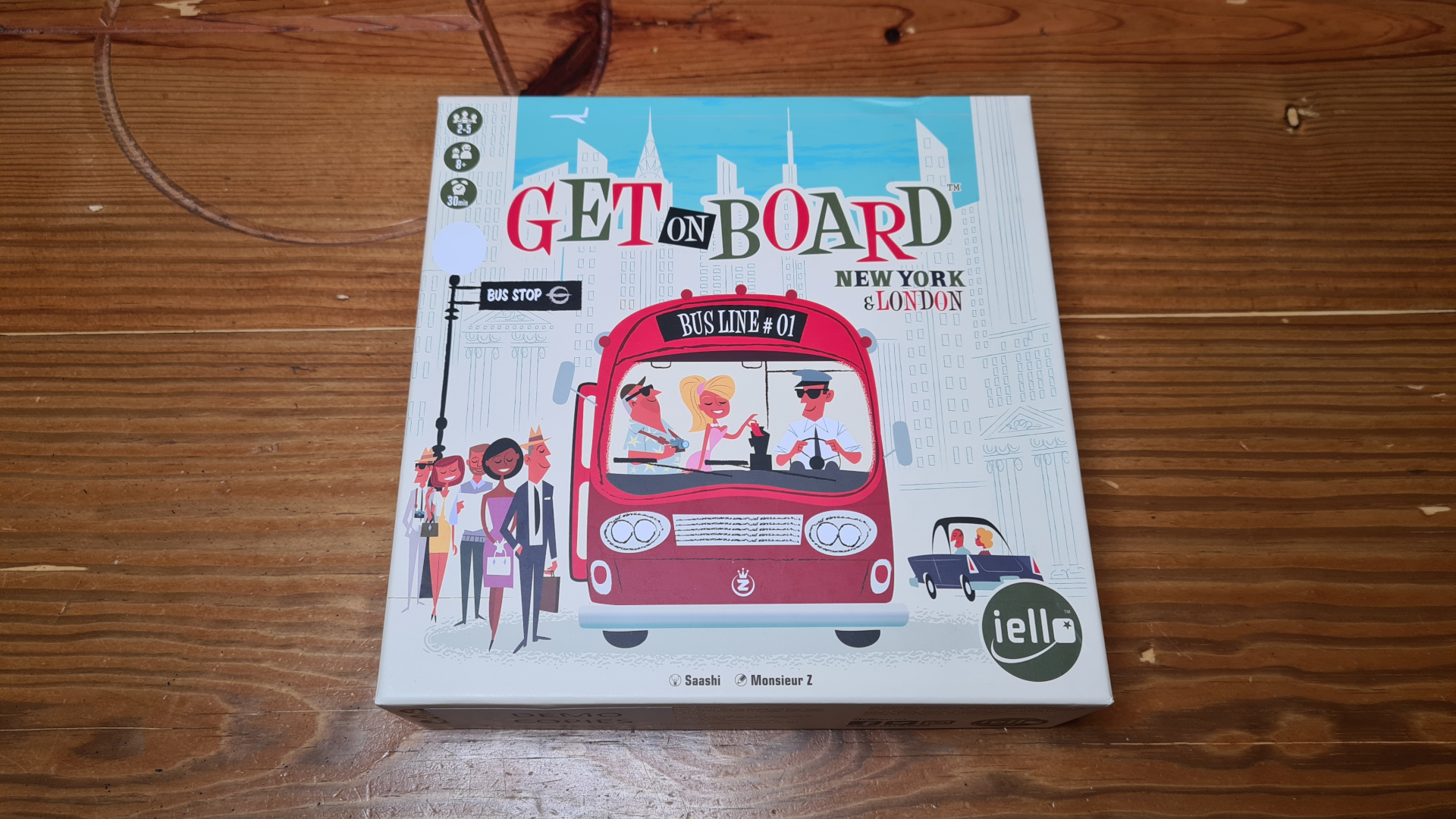Get on Board New York & London is the brand new reimplementation of Let’s Make A Bus Route. Designed by Saashi, published by IELLO, the game sees 2 – 5 players building out bus routes across cities. Taking around 30 minutes players will pick up a variety of passengers, drop some off along the way and attempt to avoid pesky traffic jams. However, is this an experience players can get on board with? Let’s find out!
At the start of the game each player takes a scoresheet from the pad and a bag of player colour pieces. Depending on the player count, New York for 2 – 3 players or the London map for 4 – 5 players, the main board is placed in the middle of the table. The deck of tickets, public and private objectives are individually shuffled. Each player is dealt two tickets and a secret private objective, with two public objectives put into play. One player is randomly chosen to be the first player, gaining the inspector token, whom starts off by revealing one of their two tickets. This choice determines the player’s starting location on the main game board. Each player clockwise around the table follows, doing the same – with all the tickets then reshuffled. Players then have the important task of naming their bus route, before the game begins.
Played over the course of 12 rounds each player takes a single turn in player order, starting with the inspector. Firstly, a card is flipped from the deck. This is numbered and indicates to all players which of the 12 routes they will get to add to the board that round. Importantly, the 12 routes players have are the same but are not in the same order, so what is the route shape for number 7 for one player will not be the same for the next.

In turn order, players place their route markers out onto the front end of their bus route. These range in length from 1 – 3 streets and also come with 0 – 2 turns. Turns can be used for left or right but the length is always followed. Players can tweak the number of turns they must use by spending a turn zone. The player adds the markers to the main board claiming the routes. Players are free to use any routes, even those already claimed. However, some darkened streets and those with other players route markers already there cause traffic jams. For each of these the player will cross off a step on their traffic jam tracker – which will lose them some points at the end of the game.
For each section of the route the player triggers the symbol at the street crossroads. These range from picking up tourists to college students, or dropping off types of passengers. Each passenger type works a little differently. The elderly just want to be picked up, scoring more as more pile onto the bus. Students score based on the number picked up multiplied by the number of college locations visited at the end of the game. Businessmen and tourists score based on how many are on board when getting to a business or tourist spot accordingly. Tourists score more points but businessmen can reward bonus passengers.
Once all players have placed their routes out, picked up or dropped off passengers then play moves onto the next round. The inspector token is passed on clockwise, with the new round seeing the next card flipped from the ticket deck. During play players will be trying to link up the locations on their private objective but also pick up the passengers or visit the locations indicated on the public objectives. These public objectives have a bit of a race element to them. They score the player who first completes them (or players if done in the same round) more points. These are flipped over offering smaller point bonuses for the remaining players. Play simply continues like this until the end of the 12th round, with the winner determined by whoever has the most points.

The main game board is double sided, though doesn’t entirely offer double the content. While the New York side plays with 2 – 3 players, the London map is only designed for 4 – 5 players. It’s a shame that there aren’t rules or a way to slim the London map to allow it to play with a wider range. Not necessarily down to 2 players but being able to play with 3 on either side would reduce the feeling for many that they won’t be playing half the content with their common gaming group.
The reasoning behind the limits make sense, as they make the experience tight regardless of the player count. Playing on the London side with 2 players would be a lackluster experience as it’s the interactions between players’ routes which make the experience. With only 2 on such a large map there may be almost no overlapping of route sections, like two solo games were going on simultaneously. It’s having to work around others, choosing when to take the hit on traffic jams, that makes the decisions crunchy.
It’s not just the risk of traffic jams, every flip of the deck creates choices for players to make. The points on offer for fulfilling personal objectives are huge. Though, so is taking that detour and picking up the additional tourist before dropping them off at that close by named location. Then, there are the public objectives ready to distract you further from what you were trying to do. With points from each angle players are left to make the important decisions of which to prioritize.

Flip and write, or in this case flip and place, games naturally have a luck factor. What normally balances things is that what is flipped is the same for all players. This isn’t quite the case with Get On Board. Still, by the end of the game everyone will have used the same set of route shapes. There is however the luck factor of when you need a straight or a route with a turn being based on what comes out of the deck. Thankfully, a mitigation is built right into the game in the form of the turn zones. It might cost points, so when to use your 5 turn tweaks is yet another choice. Still, this means over the course of the 12 rounds players can make an adjustment in just under half of them or on specific turns twice.
Some elements of Get On Board are less than intuitive. Why businessmen cause random passengers to board doesn’t entirely make sense, though it makes for interesting choices so can be forgiven. On the other hand the passenger delivery section can easily be explained with tourists wanting to go to some locations while students want their study locations linked up. This logic does help when teaching the game. Regardless, Get On Board does take a playthrough or two to get the hang of, and then it can be easily played in the 30 minute time frame as indicated on the side of the box – and much quicker at 2 players.
Played across the individual player sheets and the main board there’s never an issue working out claimed routes, nor how many passengers of each type you currently have on your bus. The wooden route markers used may not be the most enthralling component but they do the job perfectly to indicate claimed routes. At a glance you know if a route will be traffic jammed or not and can see paths along the empty streets to wiggle through if needed. A main sheet with coloured pencils or pens in the middle wouldn’t have been as legible in comparison.
Not many flip and write style titles offer any kind of player interaction. Get On Board thrives with that player interaction, as routes start to clog up the city causing traffic jams. This is why, while it is frustrating not to be able to freely use both sides of the board, the two distinct maps help keep the game tight regardless of the player count. As with similar games there is something very satisfying about best utilizing the same actions as everyone else. It’s been a rather long wait to see Let’s Make A Bus Route come over to the west, but Get On Board has made that wait worthwhile.
(Editor’s Note: Get On Board was provided to us by Coiledspring Games. Check out the official webpage here.)

